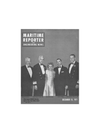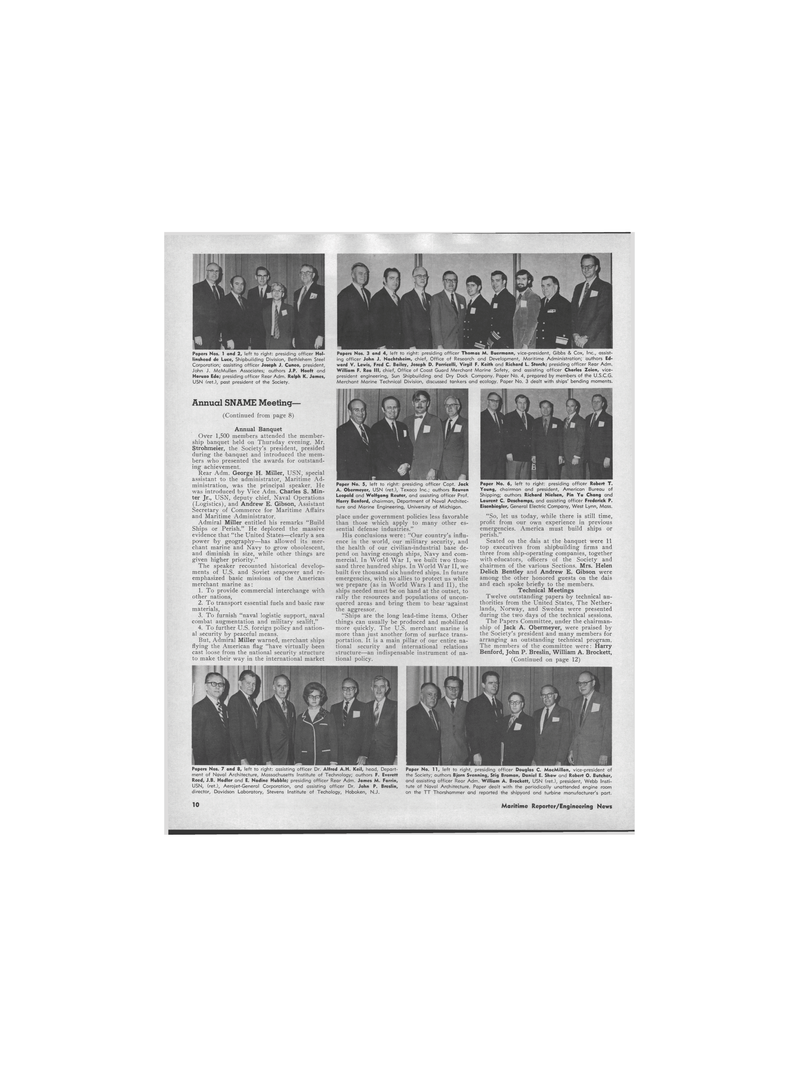
Page 8: of Maritime Reporter Magazine (December 15, 1971)
Read this page in Pdf, Flash or Html5 edition of December 15, 1971 Maritime Reporter Magazine
Papers Nos. 1 and 2, left to right: presiding officer Hol- linshead de Luce, Shipbuilding Division, Bethlehem Steel
Corporation; assisting officer Joseph J. Cuneo, president,
John J. McMullen Associates; authors J.P. Hooft and
Haruzo Eda; presiding officer Rear Adm. Ralph K. James,
USN (ret.), past president of the Society.
Papers Nos. 3 and 4, left to right: presiding officer Thomas M. Buermann, vice-president, Gibbs & Cox, Inc., assist- ing officer John J. Nachtsheim, chief, Office of Research and Development, Maritime Administration; authors Ed- ward V. Lewis, Fred C. Bailey, Joseph D. Porricelli, Virgil F. Keith and Richard L. Storch; presiding officer Rear Adm.
William F. Rea III, chief, Office of Coast Guard Merchant Marine Safety, and assisting officer Charles Zeien, vice- president engineering, Sun Shipbuilding and Dry Dock Company. Paper No. 4, prepared by members of the U.S.C.G.
Merchant Marine Technical Division, discussed tankers and ecology. Paper No. 3 dealt with ships' bending moments.
Papers Nos. 7 and 8, left to right: assisting officer Dr. Alfred A.H. Keil, head, Depart- ment of Naval Architecture, Massachusetts Institute of Technology; authors F. Everett
Reed, J.B. Hadler and E. Nadine Hubble; presiding officer Rear Adm. James M. Farrin,
USN, (ret.), Aerojet-General Corporation, and assisting officer Dr. John P. Breslin, director, Davidson Laboratory, Stevens Institute of Techology, Hoboken, N.J.
Paper No. 11, left to right, presiding officer Douglas C. MacMillan, vice-president of the Society; authors Bjorn Svenning, Stig Broman, Daniel E. Shaw and Robert O. Butcher, and assisting officer Rear Adm. William A. Brockett, USN (ret.), president, ^Vebb Insti- tute of Naval Architecture. Paper dealt with the periodically unattended engine room on the TT Thorshammer and reported the shipyard and turbine manufacturer's part.
Annual SNAME Meeting— (Continued from page 8)
Annual Banquet
Over 1,500 members attended the member- ship banquet held on Thursday evening. Mr.
Strohmeier, the Society's president, presided during the 'banquet and introduced the mem- bers who presented the awards for outstand- ing achievement.
Rear Adm. George H. Miller, USN, special assistant to the administrator, Maritime Ad- ministration, was the principal speaker. He was introduced by Vice Adm. Charles S. Min- ter Jr., USN, deputy chief, Naval Operations (Logistics), and Andrew E. Gibson, Assistant
Secretary of Commerce for Maritime Affairs and Maritime Administrator.
Admiral Miller entitled his remarks "Build
Ships or Perish." He deplored the massive evidence that "the United States—clearly a sea power by geography—has allowed its mer- chant marine and Navy to grow obsolescent, and diminish in size, while other things are given higher priority."
The speaker recounted historical develop- ments of U.S. and Soviet seapower and re- emphasized basic missions of the American merchant marine as: 1. To provide commercial interchange with other nations, 2. To transport essential fuels and basic raw materials, 3. To furnish "naval logistic support, naval combat augmentation and military sealift," 4. To further U.'S. foreign policy and nation- al security by peaceful means.
But, Admiral Miller warned, merchant ships flying the American flag "have virtually been cast loose from the national security structure to make their way in the international market
Paper No. 5, left to right: presiding officer Capt. Jack
A. Obermeyer, USN (ret.), Texaco Inc.; authors Reuven
Leopold and Wolfgang Reuter, and assisting officer Prof.
Harry Benford, chairman. Department of Naval Architec- ture and Marine Engineering, University of Michigan. place under government policies less favorable than those which apply to many other es- sential defense industries."
His conclusions were: "Our country's influ- ence in the world, our military security, and the health of our civilian-industrial base de- pend on having enough ships, Navy and com- mercial. In World War I, we built two thou- sand three hundred ships. In World War II, we built five thousand six hundred ships. In future emergencies, with no allies to protect us while we prepare (as in World Wars I and II), the ships needed must be on hand at the outset, to rally the resources and populations of uncon- quered areas and bring them to bear 'against the aggressor. "Ships are the long lead-time items. Other things can usually be produced and mobilized more quickly. The U.S. merchant marine is more than just another form of surface trans- portation. It is a main pillar of our entire na- tional security and international relations structure—an indispensable instrument of na- tional policy.
Paper No. 6, left to right: presiding officer Robert T.
Young, chairman and president, American Bureau of
Shipping; authors Richard Nielsen, Pin Yu Chang and
Laurent C. Deschamps, and assisting officer Frederick P.
Eisenbiegler, General Electric Company, West Lynn, Mass. "So, let us today, while there is still time, profit from our own experience in previous emergencies. America must build ships or perish."
Seated on the dais at the banquet were 11 top executives from shipbuilding firms and three from ship-operating companies, together with educators, officers of the Society and chairmen of the various Sections. Mrs. Helen
Delich Bentley and Andrew E. Gibson were among the other honored guests on the dais and each spoke briefly to the members.
Technical Meetings
Twelve outstanding papers by technical au- thorities from the United States, The Nether- lands, Norway, and Sweden were presented during the two days of the technical sessions.
The Papers Committee, under the chairman- ship of Jack A. Obermeyer, were praised by the Society's president and many members for arranging an outstanding technical program.
The members of the committee were: Harry
Benford, John P. Breslin, William A. Brockett, (Continued on page 12) 10 Maritime Reporter/Engineering News

 7
7

 9
9
